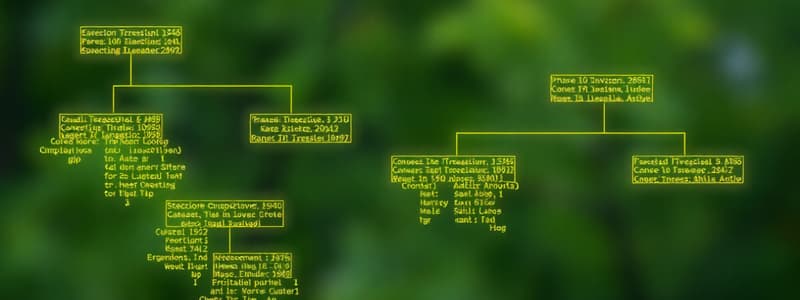Podcast
Questions and Answers
During a climbing turn:
During a climbing turn:
- the rate of climb is reduced compared to climbing straight ahead (correct)
- the aircraft tends to underbank
- the lift required increases compared to level flight
- the rate of climb unaffected
density of the atmosphere will:
density of the atmosphere will:
- increase with increase of humidity
- remain unaffected by changes of humidity
- decrease with a decrease humidity
- decrease with an increase of humidity (correct)
drag is the component of the total reaction that is:
drag is the component of the total reaction that is:
- parallel to the relative airflow (correct)
- parallel to the chord line
- parallel to longitudinal axis
- perpendicular to the longitudinal axis
due to decreasing density with increasing altitude, lift/drag ration at a given angle of attack and IAS will:
due to decreasing density with increasing altitude, lift/drag ration at a given angle of attack and IAS will:
during a change in bank, an aeroplane will rotate around its centre of:
during a change in bank, an aeroplane will rotate around its centre of:
aspect ratio can be defined as
aspect ratio can be defined as
assuming other factors remain constant, how will lift and drag vary as the angle of attack of an aerofoil is increased from 4 degrees towards the stalling angle?
assuming other factors remain constant, how will lift and drag vary as the angle of attack of an aerofoil is increased from 4 degrees towards the stalling angle?
at a constant indicated airspeed, the dynamic pressure
at a constant indicated airspeed, the dynamic pressure
at a constant power setting, the rate of climb of an aeroplane is greater when the wings are level than when in a climbing turn because level, the:
at a constant power setting, the rate of climb of an aeroplane is greater when the wings are level than when in a climbing turn because level, the:
at mean sea level, if temperature rises:
at mean sea level, if temperature rises:
at the critical angle of attack:
at the critical angle of attack:
at the stalling angle for a conventional un-swept wing:
at the stalling angle for a conventional un-swept wing:
climbing and aeroplane at higher speed than the recommended best rate of climb will result in:
climbing and aeroplane at higher speed than the recommended best rate of climb will result in:
cockpit indications which would allow a pilot to differentiate between a spiral dive and a spin would be:
cockpit indications which would allow a pilot to differentiate between a spiral dive and a spin would be:
compared to still air performance, when a tail winds exists for a descent at a constant indicated airspeed:
compared to still air performance, when a tail winds exists for a descent at a constant indicated airspeed:
compared to the maximum rate of climb, the best angle of climb is:
compared to the maximum rate of climb, the best angle of climb is:
comparing the lift coefficient and drag coefficient for a conventional aircraft at normal angles of attack:
comparing the lift coefficient and drag coefficient for a conventional aircraft at normal angles of attack:
consider the turn performance of two aeroplanes of different gross weights. At the same IAS, altitude and bank angle, the heavy aeroplane will have:
consider the turn performance of two aeroplanes of different gross weights. At the same IAS, altitude and bank angle, the heavy aeroplane will have:
Control about the lateral, normal and longitudinal axes respectively is done with:
Control about the lateral, normal and longitudinal axes respectively is done with:
as the angle of attack of an aerofoil is increased from about 4 degrees to the stalling angle, at constant indicated airspeed:
as the angle of attack of an aerofoil is increased from about 4 degrees to the stalling angle, at constant indicated airspeed:
Flashcards
Climbing turn rate of climb
Climbing turn rate of climb
Rate of climb is reduced in a climbing turn compared to straight climb.
Effect of humidity on air density
Effect of humidity on air density
When humidity increases, the density of the atmosphere decreases.
Direction of drag
Direction of drag
Drag acts parallel to the relative airflow.
Lift/drag ratio with altitude
Lift/drag ratio with altitude
Signup and view all the flashcards
Aircraft rotation axis
Aircraft rotation axis
Signup and view all the flashcards
Study Notes
Decision Trees
Definition
- Classification algorithm that divides feature space into smaller regions until each region contains data points of a single class.
- Each node represents a question about a feature.
- Each branch represents a possible answer.
- Each leaf represents a class.
Learning
- Involves two steps: tree construction and pruning.
- Tree construction involves choosing the feature that best separates the data into groups.
- Pruning involves removing insignificant branches.
Tree Construction
- A recursive process is used.
- The feature that best separates the data into two groups is selected.
- A node is created for this feature.
- Two branches are created for the two data groups.
- The process repeats for each branch.
Feature Selection Criteria
- Gini Index measures the probability that a randomly selected element will be misclassified if labeled randomly according to the distribution of labels in the set.
- $Gini = 1 - \sum_{i=1}^{n} P_i^2$, where $P_i$ is the probability of class i.
- Entropy measures disorder in a dataset.
- $H(X) = - \sum_{i=1}^{n} P(x_i) log_2 P(x_i)$, where $P(x_i)$ is the probability of the value $x_i$.
Advantages
- Easy to understand and interpret.
- Can be used for both numerical and categorical data.
- Used for classification and regression problems.
Disadvantages
- Sensitive to noise in the data.
- Prone to overfitting.
k-Nearest Neighbors (k-NN)
Definition
- Classification algorithm that assigns a data point to the most frequent class among its k-nearest neighbors.
- 'k' is a parameter.
- Distance between data points can be calculated in various ways, such as Euclidean or Manhattan distance.
Learning
- Learning involves storing the training data.
Prediction
- To predict a new data point, its distance is calculated from all training data points.
- The k-nearest neighbors are selected.
- The new point is assigned to the most frequent class among those neighbors.
Advantages
- Simple to understand and implement.
- Used for classification and regression problems.
Disadvantages
- Poor performance with large datasets.
- Sensitive to the choice of distance metric and the value of k.
- Requires data normalization.
Support Vector Machine (SVM)
Definition
- Classification algorithm that finds the hyperplane that best separates data into two classes.
- The hyperplane maximizes the margin between the two classes.
- Support vectors are the data points closest to the hyperplane.
Learning
- Finding the hyperplane that maximizes the margin between the two classes.
- This problem is solvable using quadratic programming or more efficient algorithms like gradient descent.
Prediction
- To predict a new data point, its distance is calculated from the hyperplane.
- The point is assigned to the class corresponding to the side of the hyperplane where it lies.
Advantages
- Performs well for binary classification problems.
- Relatively insensitive to noisy data.
- Can be used for nonlinear classification with the kernel trick.
Disadvantages
- Poor performance with large datasets.
- Sensitive to the choice of kernel and parameters.
Multi-Layer Perceptron (MLP)
Definition
- An artificial neural network consisting of multiple layers of interconnected neurons.
- Each neuron receives inputs from the previous layer, performs a linear transformation, and applies an activation function.
- The activation function can be sigmoid, hyperbolic tangent, or ReLU.
Learning
- Adjusting the connection weights between neurons to minimize the error between the network output and the desired output.
- The backpropagation algorithm is used to calculate the gradient of the error with respect to the weights.
- The weights are adjusted in the opposite direction of the gradient.
Prediction
- The data point is presented to the network input, and the network calculates the corresponding output to predict a new data point.
Advantages
- Can be used for complex classification problems.
- Can be used for nonlinear classification problems.
Disadvantages
- Difficult to interpret.
- Prone to overfitting.
- Requires a lot of training data.
Studying That Suits You
Use AI to generate personalized quizzes and flashcards to suit your learning preferences.




